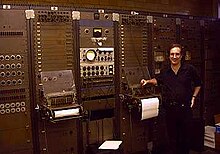Columbia-Princeton Electronic Music Center
The Computer Music Center ( CMC ) at Columbia University is the oldest center for research into electronic music and computer music in the United States . It was founded in the 1950s as the Columbia-Princeton Electronic Music Center .
place
The CMC is located at Prentis Hall, 632 West 125th Street, New York City , across from Columbia's new Manhattanville campus . The facility consists of a large research facility for academics specializing in computer music and multimedia research and a number of musical facilities and recording studios for the students.
Management, lecturers and offers
The Center offers the Sound Arts MFA Program . The head of the CMC is Brad Garton .
At the CMC, courses can be attended by George Lewis , Terry Pender , Douglas Repetto and R. Luke DuBois , among others . Numerous guest faculties offer seminars every year.
Some projects that have stood out from the CMC environment since the 1990s are:
history
The predecessor of the Columbia-Princeton Electronic Music Center was a studio founded in the early 1950s by Professors Vladimir Ussachevski and Otto Luening , both from Columbia University , and Milton Babbitt and Roger Sessions , both from Princeton University .
Originally intended for experiments in musical composition with the new reel-to-reel - tape technology , the Studio branched rapidly in all fields of research on electronic music.
The center equipment's flagship, an RCA Mark II sound synthesizer , was delivered in 1957 after it was developed by Radio Corporation of America (RCA) to specifications from Ussachevski and Babbitt. The acquisition was financed by a grant from the Rockefeller Foundation .
A number of significant pieces of the electronic music repertoire have been produced on this synthesizer, including Babbitt's Vision and Prayer and Charles Wuorinen's Time's Encomium , which won the Pulitzer Prize for Music in 1970 . In 1961 Columbia Records released a long-playing record entitled Columbia-Princeton Electronic Music Center , which was essentially produced with the RCA Mark II.
In the meantime, the RCA and the center have moved to Prentis Hall .
Many luminaries of electronic music, and of the avant-garde in music in general, visited the center, or worked or studied there, including Edgard Varèse , Halim El-Dabh , Bülent Arel , Mario Davidovsky , Charles Dodge , Pril Smiley , Alice Shields , Wendy Carlos , Dariush Dolat-Shahi and Luciano Berio .
The Electronic Music Center also acted as a consultancy for other electronic music studios in the Western Hemisphere , advising them on the optimal studio design and helping them obtain equipment.
Under Peter Mauzey, the staff at the center developed a large number of adapted devices to support the composers at the CMC. These included early prototypes of the tape delay machines, quad-microphone mixing consoles and analog adapters to enable the interconnection of incompatible synthesizer devices. The center also had a large collection of Buchla , Moog, and Serge synthesizers .
In the late 1970s, the center quickly lost its importance when the classic, analog tape techniques were gradually replaced by digital computer music. In the mid-1980s, the Columbia and Princeton facilities broke their formal merger. Princeton Music Institute intensified its collaboration with Bell Labs and founded a computer music studio under Godfrey Winham and Paul Lansky called Princeton Sound Lab .
The original Columbia facility was reorganized in 1995 under the direction of Brad Garton and renamed Columbia University Computer Music Center .
People connected to the CMC
- Bradford Garton, director, professor of music
- Terry Pender, assistant director
- Douglas Repetto, Head of the Sound Arts MFA Program
- Fred Lerdahl , professor of music
- George Lewis , professor of music
building
The building at 632 West 125th Street, called Prentis Hall , was constructed in 1906. The architect was Edgar J. Moeller . It has six floors with a total area of around 11,300 m². The building has a milk-white facade and used to be used as a milk filling plant. As part of the billion dollar expensive expansion of the campus Manhattanville of Columbia University was renovated the building and rebuilt. The university acquired the building in 1949 and used it as a chemistry research facility.
Web links
- Columbia history of the Electronic Music Center
- Ohm Site on the Electronic Music Center
- The Computer Music Center, Columbia University
- Princeton Sound Lab
- Nick Obourn, Center for Computer Music: 60 Years of Revolutionary Sound
- "Q&A: electronic music comes of age" (interview with director of research Douglas Repetto ), by Daniel Cressey, Nature , Vol. 456, N ° 7222, December 4, 2008, pg. 576; doi : 10.1038 / 456576a , OCLC 277860870 , ISSN 0028-0836
Individual evidence
- ^ "Columbia Acquires Land For Engineering Center," Brooklyn Eagle , October 16, 1949, pg. 42
- ↑ Nick Obourn: Center for Computer Music: 60 Years of Revolutionary Sound . Columbia University . Archived from the original on December 22, 2011. Retrieved on December 22, 2011.
Coordinates: 40 ° 48 ′ 59.5 " N , 73 ° 57 ′ 33.7" W.



